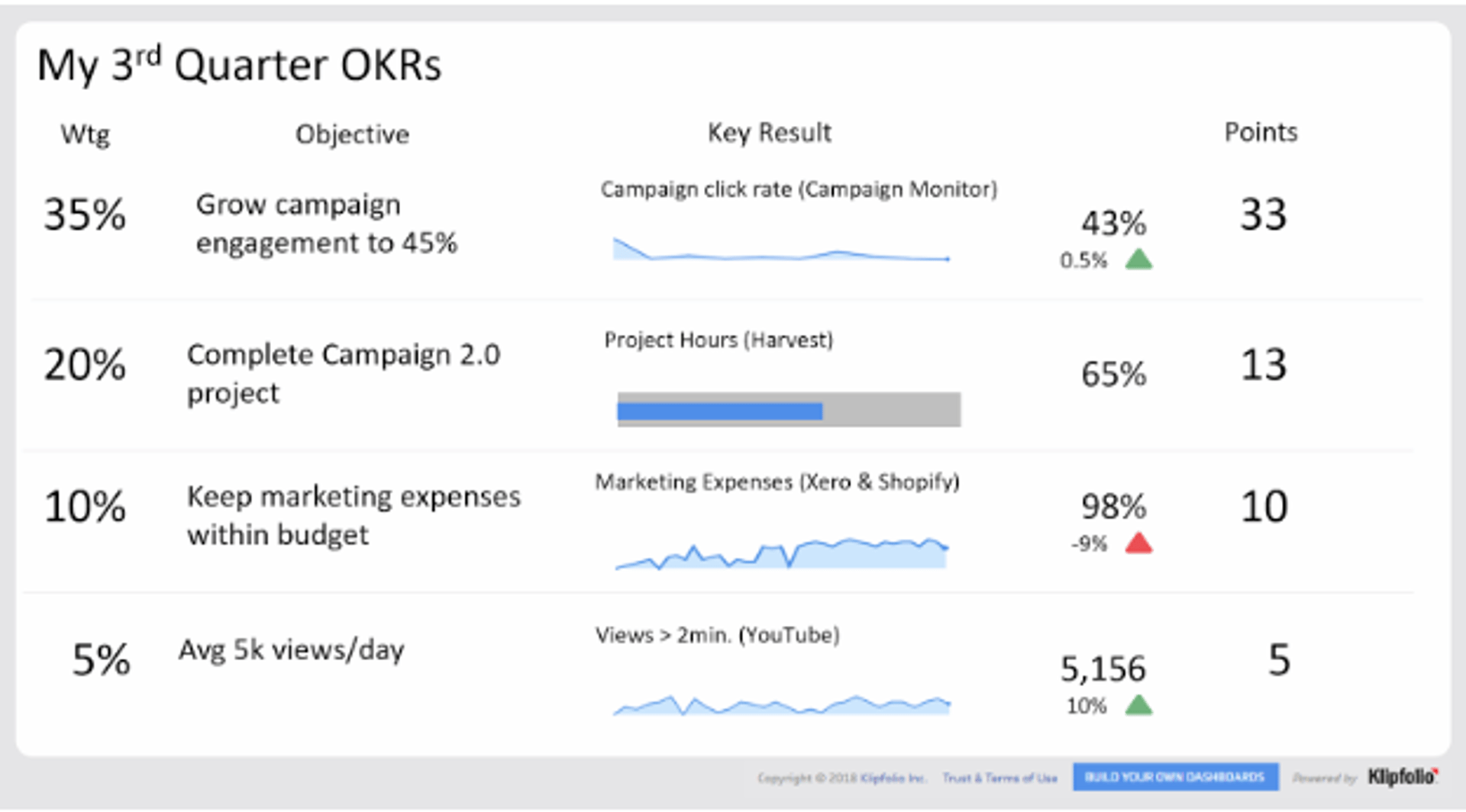5 Hacks to Writing "Measure What Matters" OKRs

Published 2023-02-15
Summary - We have helped over 3,000 people build their OKRs and have developed five initial hacks that we use to guarantee better OKRs.
A few weeks ago, we were brought in to review the OKRs developed by an organization’s internal team. They were disappointed that their OKRs were not delivering any of the benefits that John Doerr talked about in Measure What Matters. In fact, the organization was performing significantly worse than it was before they introduced OKRs.
It was something we had seen several times before – the organization followed the guidelines that were written in the book, but it was the stuff notin Doerr’s book that caused problems.
They found that:
- OKRs were seen to be a “To-Do List” with no clarity on which was more important.
- The scoring system left them baffled as to what performance made a difference.
- They found themselves bickering with each other around who was responsible for making process improvements, who was supposed to be consulted before changes got made, etc.
- Some OKRs seemed to be marketing slogans, and others were mathematical formulas, resulting in a rat-nest of confusing lists.
- Feedback was still too slow and too late to be of any value to teams and employees.
It’s always upsetting when we see this because your teams do not need to be set up for failure. We have helped over 3,000 people build their OKRs and have developed five initial hacks that we use to guarantee better OKRs.
#1 - [Verb] [Specific Noun] by [Target] in [Quarter No.]
Like square-dancing, if the moves are called out, it’s much easier for us to all do the right thing. The mechanics of OKRs are simple. Objectives are expressed as [Verb] [Specific Noun]. For example, [Grow] [New Product Sales] or “Grow new product sales”. We like the specific noun to ensure the team is focused on precisely the right , and everyone can understand it. This way we are not mistakenly chasing sales from existing customers or the same products as last year.
The target part is easier – it should line up with your strategic plan, operational budget, or whatever commitments you have made to stakeholders. Ultimately, that target needs to be broken down to what you will be doing for each of the next few quarters.
Technically, OKRs are only for the next quarter, and at the end of the quarter you create a new set of OKRs (or just KRs) for the next quarter. In reality, management needs to know your best guess as to what is going to happen each quarter headings towards that annual goal. Should they expect a huge leap in sales to happen in Q1, Q2, Q3 or Q4?
Now, when each quarter comes along, you’ll need to adjust targets for the coming quarter with the additional knowledge gained through the current quarter combined with new knowledge about the market, competitors, exchange rates, etc. Think of this like the headlights of your car… you get a clear view of everything right in front of you (i.e. current quarter), fuzzy view of the things further out (next quarter) and a best guess about what is beyond that (three and four quarters out). As each quarter passes, your headlights shine a bit further down the road.
For each business (and maybe region or product), your headlights shine out at a different distance. It is important not to drive beyond what your headlights can see. Some of our clients update their OKRs every two weeks because their businesses are so dynamic that they cannot see even four weeks out!
Please do not let anyone force you to commit to OKRs beyond what your headlights reveal.
#2 – RACI
RACI is so 1960s - but everything old is new again! What is RACI, you say? One of the most used and least understood acronyms in business. RACI is a “role clarity” model. It attempts to describe the key roles in any process: Responsible, Accountable, Consulted, Informed.
For every OKR, it will describe who is Responsible in doing that task (the job performer) and who is Accountable for making sure the process is continuously improved, and delivers what is required from it. C stands for Consulted – who must you consult if you plan on changing the process. I is for Inform - who must you inform that you have made a change.
Using RACI makes sure that we do not have overlaps, meaning you think you are accountable for the process and can change it as you see fit, but I think I am accountable for it. Overlaps can lead to conflict as we both fight to change the process to match our desires. But, underlaps can be worse - you think I am accountable for it, and I think you are accountable. In the end, which means it never gets done.
RACI allows us to be clear on who does what in advance of problems, so even when problems occur we can react quickly and effectively. In some cases, you may develop your OKRs only to the team level. Someone should still be accountable within that team for the OKR, so you will assign the “A” to someone on that team.
Depending on the culture in your company, you can either skip the “C” and “I” or go the other way and add in more letters, such as “S” (RASCI) to capture the Support you need from other teams or departments. Wikipedia can give you a pile of other acronyms, find the collection of letters that best suits your company!
#3 – Keeping Strategic Score
This hack is easy to explain, but harder to implement. Imagine if you could assign “strategy points” for everything you did. The more your activity enables the strategic goals, the more points you earn. Imagine that every week, day or month you could see how many strategy points you earned. You could then figure out how to maximize points earned for your efforts.
These strategy points work at all levels – individuals, teams, departments – and corporate.
We call that the gamification of business.
The great news is, once installed you need never have an annual performance review again! You can manage your own career every week, day or month, you can see what results you get based on the different tasks you do. For example, once the strategy changes, you can immediately see what you need to change in order to maximize points under the new priority set.
Pretty cool, right?
Now, the trickier part is putting that strategy-points system in place. It’s not all that tough - but merely different from what you do currently. The strategy-points available are the impact of your OKR multiplied by the priority of the strategic objective(s) it affects. From there, multiply the available points by your actual performance level to determine the number of points earned.
If you used numbers, you could do the following:
Say a Strategic Objective is weighted at 15%. And say you have a process that has a 9 out of 10 impact on that Strategic Objective, performing at a 6 out of 10 (where 10 is the KR target). The strategy points earned is 15% x 9 x 6 or 8 strategy points. It’ll look a bit like this on your OKR dashboard:

#4 – Setting Priorities and Changing Them
Not all OKRs are created equally. Michael Porter says something like “strategy is more about what you stop doing then what you start doing”. We need to give clear instructions to everyone on what they should start doing and what they should stop doing - and guess what? OKRs are the ideal way to capture and communicate those priorities.
At some point, we need to understand leadership’s priorities for the top level Strategic Objectives. For example, is it more important that we get revenue growth from existing customers or revenue growth from new customers?
From there, we need a way to accurately cascade those priorities down and across the organization. So, for our example, to exceed sales targets and achieve higher sales growth from new customers, maybe Marketing’s highest priority is around identifying and targeting new customer segments. Sales’ highest priority is on quickly and effectively processing new customers. Product Development may need to identify and develop products which are of the greatest interest to those new segments. Each department has a different priority in contributing to the overall OKR.
The benefit of this cascade linkage is that everyone is aligned and working on the right things.
Later, if leadership needs to change the priorities, deciding the company needs to get more revenue from existing customers instead, we can all quickly see how our department, team, and individual priorities change based on that new direction. By adjusting OKRs we can swiftly change the organization’s direction.
Here’s what we have also discovered - no matter how hard leadership researches, discusses and considers their priorities, they will be or at least partially wrong. Why? Because we never have complete knowledge and because our business world rapidly changes. The external market changes, our ability to execute changes, or any of a million unforecasted events will occur. Successful organizations need the ability to quickly change direction faster than their environments and competition.
The OKR system linked to your strategic priorities allows the organization to change direction faster than changing itself.
#5 – Coach, Mentor, Protect and Train
Our extensive experience with OKRs tells us that no matter how long your OKR team works in a room, they will never come up with the perfect collection of OKRs. This is not unlike learning to ride a bike… sooner or later you have to just hop on and use the skills you have to figure it out.
With OKRs, we generally suggest that it will take three quarters (nine months) for your team to build the culture and engagement needed in order to make your OKR solution self-sustaining.
Over those first nine months, and from then on, it is the job of leadership to nurture the OKR process. You must constantly show everyone how to use the OKRs to answer all company performance questions. You must constantly coach on how to use OKRs to problem solve, allocate resources, and work as a team. You must show them by example on how OKRs make their jobs easier and better aligned with the rest of the organization. You need to protect your team against those who would sabotage the old KR process or usurp it for their own benefits. And you must constantly train them on best management practices.
Like bringing up awesome children or training a puppy, this investment will pay you back in multiples of the effort you put in. But you have to put that effort in!
Other hacks?
Now, I’d hate to have you accuse me of false advertising - but the above five hacks are guaranteed to give you better OKRs. However, there are a smorgasbord of other OKR hacks that we draw from in a unique way for each different situation and scenario. It is a bit like playing golf – the mix of the tools (clubs), your swing (available skills) and course management (strategy) dictate the best approach. I guess that makes us a great caddie!
About Pm2
Brett is an Executive Partner at Pm2 (Performance Measurement & Management) an international consulting firm specializing in the development and implementation of strategic dashboards and scorecards. The frameworks they use includes OKRs (Objective and Key Results), Balanced Scorecard, 4DX (Four Disciplines of Execution) Lean, Six-Sigma, etc. Their work has been profiled in Harvard Business Review, Fortune and Forbes magazines as well as countless business books and periodicals. We are pleased to have this thought leader as an active contributor to our blog posts.
Related Articles

Klipfolio Partner How-To #1: Duplicating dashboards across client accounts
By Stef Reid — November 27th, 2025
Klipfolio Partner How-To #2: Company Properties can simplify client set-up
By Stef Reid — November 26th, 2025
Real-time dashboards: Actionable data insight for CMOs
By Elias Crum — September 6th, 2023

